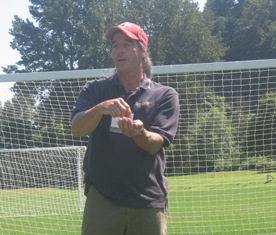I’m still down in the Caribbean but I have been getting an earful about your winter woes across the country. Snowfall records were set for Central Park in February as well as many Midwestern states, while municipalities have been reporting a record number of water main line breaks as the frost depth creeps well below 3 feet.
So maybe you have wondered what this all means for your athletic field turf. Snow is usually our friend because it insulates fields and reduces direct low temperature injury as well as winter desiccation. Even though air temperature and wind chill can be very cold in the winter the earth continues to emit heat from its core and the snow traps the heat much like a tarped field. The snow also prevents direct contact with the sun and wind that can cause excessive plant drying when water can’t be extracted from the frozen ground.
Snow cover is a little unpredictable so turf covers are a good choice to prevent desiccation and offer earlier spring green-up. The only real down side to snow cover is increased disease from pink and brown snow molds. If snow mold is a real problem for your field situation then preventative fungicides can be applied in the late fall just before the first snow flies in the winter. If caught with substantial snow mold and a sea of matted grass, then fluff up the matted grass to speed recovery using a spring tooth drag, Fuerst harrow, or rake.
Direct low temperature kill can also occur during the winter from extremely low temperatures or moderately low temperatures that last for a long time. This year the deep frost line indicates that we have had both extremely low temperatures and moderately low temperatures for an extended period of time. Here is how I rank the potential for turf loss based on low temperature kill from most injury to least injury; bermudagrass > zoysiagrass > annual bluegrass >perennial ryegrass = turf type tall fescue > Kentucky bluegrass.
Fields often collect pockets of surface water that can freeze like little ice rinks with a half inch of ice. Ice injury is far more damaging on golf courses where mowing heights are lower and the amount of annual bluegrass is greater. Annual bluegrass is also becoming more of a nuisance as sports turf creeps below the 1.5 inch mowing height and our research shows that annual bluegrass does not like to be covered in an impermeable layer of ice. So improve your drainage and reduce your annual bluegrass or Mother Nature may do it for you.
As the ground begins to thaw and before things begin to green up there is usually a month where you are wondering just what the spring will bring. On questionable fields where injury may have occurred make the crystal ball a little clearer by gazing at a plug of grass a month in advance of green up. Every year since I’ve been in the turf business (except this year because remember, I’m stuck in the Caribbean) I have taken field samples of grass and grown them in the greenhouse to determine if the grass is dead or alive. Just keep them warm and moist and put them on the window sill; you don’t need a greenhouse. A cup cutter won’t work on frozen ground; use a sawzall or chisel and 5-pound hammer. Those of you pushing bermudagrass farther to the north would be wise to make this a routine practice. It would be nice to know if your grass is dead so you can anticipate all the problems that lie ahead from personnel communication to developing a regressing plan.
On another note I am still helping with the local school field here on St. John and they have been playing multiple sports for years on a field shared with the community that is mostly dirt and rocks. Last year the community rallied with their support of labor and the field was scratched up using backhoes, the only equipment available on the island. The field did well for a while but I am needing a few basic things to take this field to the next level of safety and pride: fertilizer, a hybrid seeded or vegetative bermudagrass, a walk-behind broadcast spreader, backpack sprayer, and a topdresser; the topdresser is an optional luxury because we used 25 people to spread 40 tons of sand and we can do that again. There is no doubt that we can grow grass on the field, I just need a few resources; any help would be welcome. Call me at 340-514-4740 and I’ll send you a little warmth. Tank-u- mon.


